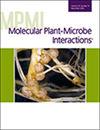求助PDF
{"title":"From Lesions to Lessons: Two Decades of Filamentous Plant Pathogen Genomics.","authors":"Wagner C Fagundes, Yu-Seng Huang, Sophia Häußler, Thorsten Langner","doi":"10.1094/MPMI-09-24-0115-FI","DOIUrl":null,"url":null,"abstract":"<p><p>Many filamentous microorganisms, such as fungi and oomycetes, have evolved the ability to colonize plants and cause devastating crop diseases. Coevolutionary conflicts with their hosts have shaped the genomes of these plant pathogens. Over the past 20 years, genomics and genomics-enabled technologies have revealed remarkable diversity in genome size, architecture, and gene regulatory mechanisms. Technical and conceptual advances continue to provide novel insights into evolutionary dynamics, diversification of distinct genomic compartments, and facilitated molecular disease diagnostics. In this review, we discuss how genomics has advanced our understanding of genome organization and plant-pathogen coevolution and provide a perspective on future developments in the field. [Formula: see text] Copyright © 2025 The Author(s). This is an open access article distributed under the CC BY 4.0 International license.</p>","PeriodicalId":19009,"journal":{"name":"Molecular Plant-microbe Interactions","volume":" ","pages":"187-205"},"PeriodicalIF":3.4000,"publicationDate":"2025-03-01","publicationTypes":"Journal Article","fieldsOfStudy":null,"isOpenAccess":false,"openAccessPdf":"","citationCount":"0","resultStr":null,"platform":"Semanticscholar","paperid":null,"PeriodicalName":"Molecular Plant-microbe Interactions","FirstCategoryId":"99","ListUrlMain":"https://doi.org/10.1094/MPMI-09-24-0115-FI","RegionNum":3,"RegionCategory":"生物学","ArticlePicture":[],"TitleCN":null,"AbstractTextCN":null,"PMCID":null,"EPubDate":"2025/4/24 0:00:00","PubModel":"Epub","JCR":"Q2","JCRName":"BIOCHEMISTRY & MOLECULAR BIOLOGY","Score":null,"Total":0}
引用次数: 0
引用
批量引用
Abstract
Many filamentous microorganisms, such as fungi and oomycetes, have evolved the ability to colonize plants and cause devastating crop diseases. Coevolutionary conflicts with their hosts have shaped the genomes of these plant pathogens. Over the past 20 years, genomics and genomics-enabled technologies have revealed remarkable diversity in genome size, architecture, and gene regulatory mechanisms. Technical and conceptual advances continue to provide novel insights into evolutionary dynamics, diversification of distinct genomic compartments, and facilitated molecular disease diagnostics. In this review, we discuss how genomics has advanced our understanding of genome organization and plant-pathogen coevolution and provide a perspective on future developments in the field. [Formula: see text] Copyright © 2025 The Author(s). This is an open access article distributed under the CC BY 4.0 International license.
从病变到教训:丝状植物病原体基因组学二十年。
丝状植物病原体对粮食安全构成严重威胁。目前的估计表明,收获前和收获后病害造成的产量损失高达23%,而且由于气候变化,预计这些损失还会增加(Singh等人,2023;Chaloner et al. 2021;Stukenbrock and Gurr 2023;Fisher et al. 2012;Steinberg and Gurr 2020)。了解丝状植物病原体如何出现、传播和适应其宿主和新的环境生态位对于解决它们对全球农业的破坏性影响至关重要。在过去的二十年里,基因组学已经成为一项核心技术,以促进我们对丝状植物病原体的种群动态和共同进化的理解。第一个丝状植物病原体——稻瘟病菌的基因组序列是在20年前完成的。从那时起,植物病原体基因组学不仅提供了对植物病原体种群基因组组成的深入了解,而且已经成为基因发现,疾病诊断和加速分子生物学的基础技术。在短短二十年里,我们见证了该领域的几次革命,包括许多丝状植物病原体的第一个参考基因组,数千个个体的群体规模基因组学,高度连续组装的长读和染色体构象测序以及基因组学和结构生物学的最新交叉。在这里,我们通过介绍重要的技术进步(图1)和我们从过去20年的丝状植物病原体基因组学中吸取的教训来纪念20周年,重点是谷物疾病。
本文章由计算机程序翻译,如有差异,请以英文原文为准。

 求助内容:
求助内容: 应助结果提醒方式:
应助结果提醒方式:


